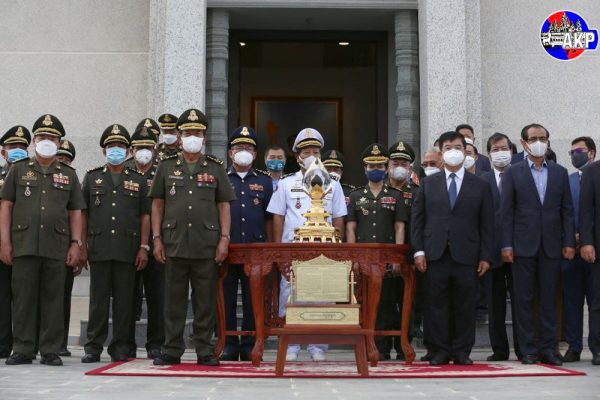This morning, the first drop of oil extracted from Cambodia’s offshore deposits was ceremonially installed at the Win-Win Monument in the country’s capital Phnom Penh.
According to the state media agency Agence Kampuchea Presse, the oil, enclosed within a tear-shaped glass ampoule perched on a golden stand (see photo), was installed in the monument by Minister of Energy and Mines Suy Sem and Tea Banh, Cambodia’s minister of defense, who also chaired the committee tasked with constructing the $12 million monument.
In a speech, Tea Banh described the extraction of oil as “an important first step for the country to build national capacity and its oil, gas, and energy industry.”
This should have been a big moment for the Cambodian government. For more than two decades, it has harbored ambitions of exploiting its offshore oil and gas deposits in the Gulf of Thailand, but has struggled to get production off the ground, largely due to depressed global oil prices. In 2017, the Cambodian government finally signed a joint venture with Singapore’s KrisEnergy to develop more than 3,000 square kilometers known as Block A, with production initially scheduled to begin in 2019.
During that time, Hun Sen and his government have imbued the extraction of oil reserves with a huge degree of symbolic significance: as a sign of the country’s emergence from decades of chaos under the aegis of the ruling Cambodian People’s Party (CPP).
Enjoying this article? Click here to subscribe for full access. Just $5 a month.
In a speech marking the first extraction of oil on December 29 of last year, the 22nd anniversary of the end of the Cambodian civil war, Hun Sen explicitly linked the two events. “This is a source of pride for Cambodia as we are a small country,” Hun Sen said in the speech. “If there were no end to the war, how could there be peace,” he added, “If there is no peace, there will be no first oil drop event on December 29, 2020.”
It is thus only natural that the achievement would be enshrined within the Win-Win Monument. Completed in 2018 with donations from prominent tycoons, the 33-meter-high concrete monument was constructed by Hun Sen’s government to commemorate its own legacy and achievements, particularly the “win-win strategy” – basically a mix of military offensives and political amnesties – that helped to bring Cambodia’s civil war to an end in the late 1990s.
Diplomat Brief Weekly Newsletter N Get briefed on the story of the week, and developing stories to watch across the Asia-Pacific. Get the Newsletter
According to AKP, the glass globe of crude oil will be displayed in the Techo Sen Guidance Museum, named after one of Hun Sen’s many honorifics, that is housed inside the monument and functions as a repository for objects and relics from the Cambodian leader’s long career. The oil has also been christened “Patham Telak Pinthu Kampuchea,” which means “Cambodia’s first drop of oil” in Pali, the sacred language of Buddhist scripture.
But the small capsule of oil may end up being all that comes from the much-vaunted offshore oil fields. On June 4, just five days before today’s ceremony, KrisEnergy announced that it was filing for bankruptcy, claiming that it “is unable to pay its debts based on actual and/or contingent liabilities and will proceed to liquidation.” While the local subsidiary says it will continue its Cambodia operations, it has dealt the government’s dream of oil-financed prosperity a serious blow.
Back in January, a few days after the first drops of crude trickled from KrisEnergy’s offshore rigs, I described the extraction of oil as a “game-changing” event for Cambodia, arguing that would lead Hun Sen and the CPP to wean themselves fully of outside sources of support, and thus entrench their power.
What I failed to take into account was the poor production from Block A, to say nothing of the precarious financial situation of KrisEnergy. According to reports in industry trade publications, the company has long been in dire financial straits, and was hoping that returns from Cambodia’s Block A oil field would prevent it from going bust. But its projections were described by industry insiders as “wildly optimistic.”
Sure enough, in early April, KrisEnergy stated that output at the Cambodia field was less than half of the originally expected rate, prompting the government to warn it that it faced fines or worse if the situation did not improve. By the end of that month, one publication was describing the company as being “on the verge of collapse.”
Given that most of Cambodia’s oil wealth would most likely have been gobbled up by its rapacious ruling elite, the poor performance of the offshore field will probably make little different to the man and woman on the street. But having imbued the extraction of oil with such significance, as a symbol of Cambodia’s progress under the benign hand of the CPP, the capsule housed in Hun Sen’s monument may end up being symbolic in an entirely unintended way.
